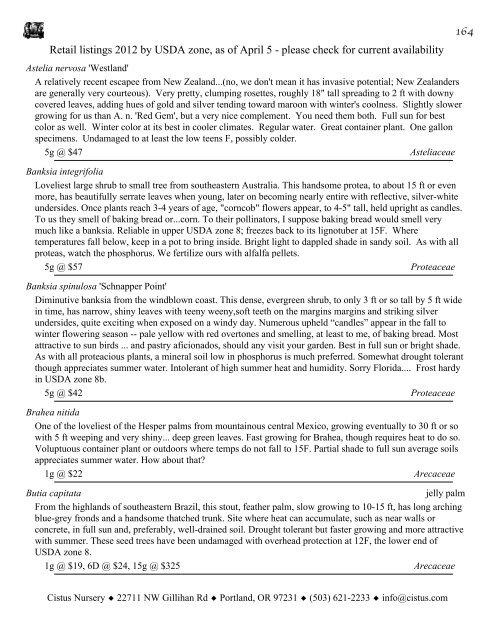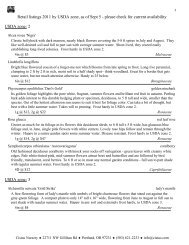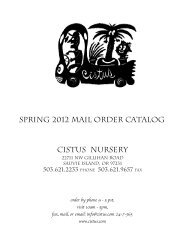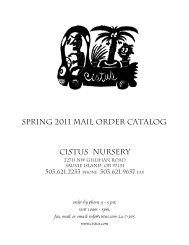1 Retail listings 2012 by USDA zone, as of April 5 ... - Cistus Nursery
1 Retail listings 2012 by USDA zone, as of April 5 ... - Cistus Nursery
1 Retail listings 2012 by USDA zone, as of April 5 ... - Cistus Nursery
You also want an ePaper? Increase the reach of your titles
YUMPU automatically turns print PDFs into web optimized ePapers that Google loves.
<strong>Retail</strong> <strong>listings</strong> <strong>2012</strong> <strong>by</strong> <strong>USDA</strong> <strong>zone</strong>, <strong>as</strong> <strong>of</strong> <strong>April</strong> 5 - ple<strong>as</strong>e check for current availability<br />
Astelia nervosa 'Westland'<br />
A relatively recent escapee from New Zealand...(no, we don't mean it h<strong>as</strong> inv<strong>as</strong>ive potential; New Zealanders<br />
are generally very courteous). Very pretty, clumping rosettes, roughly 18" tall spreading to 2 ft with downy<br />
covered leaves, adding hues <strong>of</strong> gold and silver tending toward maroon with winter's coolness. Slightly slower<br />
growing for us than A. n. 'Red Gem', but a very nice complement. You need them both. Full sun for best<br />
color <strong>as</strong> well. Winter color at its best in cooler climates. Regular water. Great container plant. One gallon<br />
specimens. Undamaged to at le<strong>as</strong>t the low teens F, possibly colder.<br />
5g @ $47 Asteliaceae<br />
Banksia integrifolia<br />
Loveliest large shrub to small tree from southe<strong>as</strong>tern Australia. This handsome protea, to about 15 ft or even<br />
more, h<strong>as</strong> beautifully serrate leaves when young, later on becoming nearly entire with reflective, silver-white<br />
undersides. Once plants reach 3-4 years <strong>of</strong> age, "corncob" flowers appear, to 4-5" tall, held upright <strong>as</strong> candles.<br />
To us they smell <strong>of</strong> baking bread or...corn. To their pollinators, I suppose baking bread would smell very<br />
much like a banksia. Reliable in upper <strong>USDA</strong> <strong>zone</strong> 8; freezes back to its lignotuber at 15F. Where<br />
temperatures fall below, keep in a pot to bring inside. Bright light to dappled shade in sandy soil. As with all<br />
prote<strong>as</strong>, watch the phosphorus. We fertilize ours with alfalfa pellets.<br />
5g @ $57 Proteaceae<br />
Banksia spinulosa 'Schnapper Point'<br />
Diminutive banksia from the windblown co<strong>as</strong>t. This dense, evergreen shrub, to only 3 ft or so tall <strong>by</strong> 5 ft wide<br />
in time, h<strong>as</strong> narrow, shiny leaves with teeny weeny,s<strong>of</strong>t teeth on the margins margins and striking silver<br />
undersides, quite exciting when exposed on a windy day. Numerous upheld “candles” appear in the fall to<br />
winter flowering se<strong>as</strong>on -- pale yellow with red overtones and smelling, at le<strong>as</strong>t to me, <strong>of</strong> baking bread. Most<br />
attractive to sun birds ... and p<strong>as</strong>try aficionados, should any visit your garden. Best in full sun or bright shade.<br />
As with all proteacious plants, a mineral soil low in phosphorus is much preferred. Somewhat drought tolerant<br />
though appreciates summer water. Intolerant <strong>of</strong> high summer heat and humidity. Sorry Florida.... Frost hardy<br />
in <strong>USDA</strong> <strong>zone</strong> 8b.<br />
5g @ $42 Proteaceae<br />
Brahea nitida<br />
One <strong>of</strong> the loveliest <strong>of</strong> the Hesper palms from mountainous central Mexico, growing eventually to 30 ft or so<br />
with 5 ft weeping and very shiny... deep green leaves. F<strong>as</strong>t growing for Brahea, though requires heat to do so.<br />
Voluptuous container plant or outdoors where temps do not fall to 15F. Partial shade to full sun average soils<br />
appreciates summer water. How about that?<br />
1g @ $22 Arecaceae<br />
Butia capitata jelly palm<br />
From the highlands <strong>of</strong> southe<strong>as</strong>tern Brazil, this stout, feather palm, slow growing to 10-15 ft, h<strong>as</strong> long arching<br />
blue-grey fronds and a handsome thatched trunk. Site where heat can accumulate, such <strong>as</strong> near walls or<br />
concrete, in full sun and, preferably, well-drained soil. Drought tolerant but f<strong>as</strong>ter growing and more attractive<br />
with summer. These seed trees have been undamaged with overhead protection at 12F, the lower end <strong>of</strong><br />
<strong>USDA</strong> <strong>zone</strong> 8.<br />
1g @ $19, 6D @ $24, 15g @ $325 Arecaceae<br />
<strong>Cistus</strong> <strong>Nursery</strong> ◆ 22711 NW Gillihan Rd ◆ Portland, OR 97231 ◆ (503) 621-2233 ◆ info@cistus.com<br />
164







